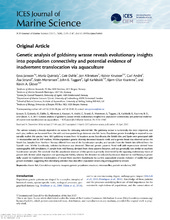| dc.contributor.author | Jansson, Eeva | |
| dc.contributor.author | Sanchez, Maria Quintela | |
| dc.contributor.author | Dahle, Geir | |
| dc.contributor.author | Albretsen, Jon | |
| dc.contributor.author | Knutsen, Halvor | |
| dc.contributor.author | André, Carl | |
| dc.contributor.author | Strand, Åsa | |
| dc.contributor.author | Mortensen, Stein | |
| dc.contributor.author | Taggart, John B. | |
| dc.contributor.author | Karlsbakk, Egil | |
| dc.contributor.author | Kvamme, Bjørn Olav | |
| dc.contributor.author | Glover, Kevin | |
| dc.date.accessioned | 2018-04-26T13:12:48Z | |
| dc.date.available | 2018-04-26T13:12:48Z | |
| dc.date.issued | 2017 | |
| dc.Published | Jansson E, Sanchez MQ, Dahle G, Albretsen J, Knutsen H, André C, Strand Å, Mortensen S, Taggart J, Karlsbakk E, Kvamme BO, Glover KA. Genetic analysis of goldsinny wrasse reveals evolutionary insights into population connectivity and potentialevidence of inadverent translocationvia aquaculture. ICES Journal of Marine Science. 2017;74(8):2135-2147 | eng |
| dc.identifier.issn | 1054-3139 | en_US |
| dc.identifier.issn | 1095-9289 | en_US |
| dc.identifier.uri | https://hdl.handle.net/1956/17663 | |
| dc.description.abstract | The salmon industry is heavily dependent on wrasse for delousing infected fish. The goldsinny wrasse is numerically the most important, and each year, millions are harvested from the wild and transported large distances into fish farms. Population genetic knowledge is required to sustainably exploit this species. Here, 1051 goldsinny wrasses from 16 locations across Scandinavia, the British Isles, and Spain were genotyped with 14 microsatellite and 36 SNP markers. Within-population genetic diversity decreased towards north, and a genetic break was observed across the North Sea. Samples from Northern Norway differed from rest of the Scandinavian samples, and samples from the British Isles differed from the Spanish ones. Within Scandinavia, isolation-by-distance was detected. Observed genetic patterns fitted well with expectations derived from oceanographic drift simulations. A sample from mid-Norway deviated from these patterns however, and was genetically very similar to southern Scandinavian samples. We conclude that the population structure of this species is primarily determined by the opposing evolutionary forces of passive drift, limited adult migration and spawning-site fidelity, whereas the deviation in isolation-by-distance observed in mid-Norway is potentially caused by inadvertent translocations of wrasse from southern Scandinavia via current aquaculture practise. Inclusion of outlier loci gave greater resolution, suggesting that diversifying selection may also affect population structuring among goldsinny wrasses. | en_US |
| dc.language.iso | eng | eng |
| dc.publisher | Oxford University Press | en_US |
| dc.rights | Attribution CC BY | eng |
| dc.rights.uri | http://creativecommons.org/licenses/by/4.0 | eng |
| dc.subject | cleaner fish | eng |
| dc.subject | Ctenolabrus rupestris | eng |
| dc.subject | escapees | eng |
| dc.subject | genetic population structure | eng |
| dc.subject | Microsatellite | eng |
| dc.subject | particle simulation | eng |
| dc.subject | SNP | eng |
| dc.title | Genetic analysis of goldsinny wrasse reveals evolutionary insights into population connectivity and potentialevidence of inadverent translocationvia aquaculture | en_US |
| dc.type | Peer reviewed | |
| dc.type | Journal article | |
| dc.date.updated | 2018-02-01T14:21:35Z | |
| dc.description.version | publishedVersion | en_US |
| dc.rights.holder | Copyright 2017 International Council for the Exploration of the Sea | en_US |
| dc.identifier.doi | https://doi.org/10.1093/icesjms/fsx046 | |
| dc.identifier.cristin | 1560582 | |
| dc.source.journal | ICES Journal of Marine Science | |

